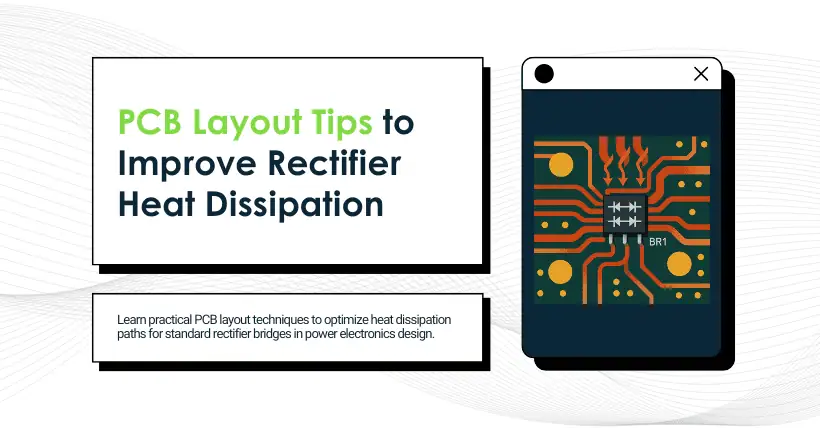In modern electronic products, MDD general-purpose rectifier bridges are widely used in AC/DC conversion circuits, such as power adapters, LED drivers, power tools, and household appliance control boards. As system integration increases and product miniaturization becomes more prominent, thermal management issues of rectifier bridges are gradually emerging. Especially in medium- to high-current applications, proper PCB layout can not only improve the heat dissipation efficiency of the rectifier bridge but also enhance system reliability and lifespan.
This article systematically analyzes the layout optimization strategies for general-purpose rectifier bridges from the perspective of PCB thermal path design.
I. Root Cause of Heat Dissipation Needs—Power Loss Analysis
During operation, a general-purpose rectifier bridge mainly generates power loss due to its forward voltage drop (VF). Taking a rectifier bridge with a rectifying current of 2A and a forward voltage drop of 1V as an example, since each diode conducts for about 50% of each cycle, the average power loss for each pair of diodes is:
Power loss ≈ 1V × 2A × 50% × 2 ≈ 2W
If this 2W of heat is not effectively dissipated into the environment, it will lead to an increase in junction temperature inside the rectifier bridge, which can cause thermal breakdown, parameter drift, or even failure. Therefore, PCB-level thermal management design is crucial.
II. Three Major Principles for Building Heat Dissipation Paths
- Increase Copper Foil Area
The pins of the rectifier bridge (especially the AC input and DC output ends) should be connected to large copper foil areas to form effective heat dissipation zones. For example, the copper pour can fill the blank areas of the corresponding nets, and thermal vias can be used to conduct heat to internal or bottom layers of the board. - Arrange Heat Flow Paths Reasonably
The rectifier bridge should be placed in areas of the PCB with higher thermal capacity, avoiding proximity to heat-sensitive components or densely routed regions. It is recommended to arrange the positive and negative DC output copper areas oppositely to form a “thermal convection channel,” thereby enhancing thermal radiation and conduction efficiency. - Use Thermal Vias and Auxiliary Copper Layers
In double-sided or multi-layer PCBs, multiple thermal vias (typically with a diameter of 0.3–0.5 mm and spacing of about 1 mm) should be placed under or around the rectifier bridge pins, connecting to large copper areas or ground planes on lower layers. This helps to quickly conduct heat to cooler regions and reduce surface temperature buildup.
III. Co-Optimization of Packaging and Layout
- Select Appropriate Package Structure
Different rectifier bridge packages offer varying heat dissipation capabilities. For example:
- DIP packages (e.g., KBPC series) come with screw holes, suitable for mounting on metal heat sinks with bolts;
- SMD packages (e.g., MB6S, GBU4K) rely on PCB dissipation and depend heavily on copper pour and via design;
- Packages with metal bases and heat sinks (e.g., KBP, GBJ) are suitable for using thermal pads on the bottom side to enhance heat transfer.
- Use Thermal Interface Materials
Thermal grease or thermal pads can be applied under the rectifier bridge and used with a metal enclosure or aluminum substrate to further enhance convection and radiation.
For high-power applications, it is recommended to install heat sink brackets under the rectifier bridge and secure them with screws to strengthen heat conduction.
IV. Practical Case Reference
In the design of an LED streetlight driver power supply, a GBU6K rectifier bridge is used, with an input of 220V AC and a maximum output current of 3A. The design layout includes:
- GBU rectifier bridge placed near the edge of the PCB close to the metal enclosure;
- 20mm × 30mm copper area laid out for each of the four pin zones;
- Six thermal vias under each pin connecting to the full ground plane on the bottom layer;
- GND layer connected to the aluminum casing, which acts as an auxiliary heat sink;
- Key thermal paths coated and bonded with thermal silicone.
Final testing showed that under full load, the temperature rise of the rectifier bridge was kept within 45°C, significantly better than a design without copper pour (temperature rise exceeding 80°C).
Therefore, as one of the high-power devices in power supply design, the stability of the MDD rectifier bridge is closely related to the system’s thermal design. Through proper PCB layout—including optimized copper pouring, thermal via assistance, package selection, and integrated thermal path design—the rectifier bridge’s heat dissipation performance can be significantly improved, thereby enhancing the overall safety and reliability of the system. As an FAE, never overlook these “invisible” thermal management details when supporting customer product development—they are often key to ensuring long-term stable product operation.
Related:

Disclaimer:
- This channel does not make any representations or warranties regarding the availability, accuracy, timeliness, effectiveness, or completeness of any information posted. It hereby disclaims any liability or consequences arising from the use of the information.
- This channel is non-commercial and non-profit. The re-posted content does not signify endorsement of its views or responsibility for its authenticity. It does not intend to constitute any other guidance. This channel is not liable for any inaccuracies or errors in the re-posted or published information, directly or indirectly.
- Some data, materials, text, images, etc., used in this channel are sourced from the internet, and all reposts are duly credited to their sources. If you discover any work that infringes on your intellectual property rights or personal legal interests, please contact us, and we will promptly modify or remove it.








